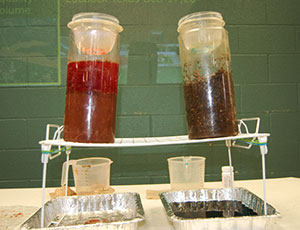Soil Health 101 Reveals Secrets Underfoot
The Natural Resources Conservation Service (NRCS) hosted four Soil Health 101 workshops during mid-January 2014 in Woodward, Wagoner, Atoka, and Fort Cobb for NRCS and Oklahoma Conservation Commission (OCC) staff. The workshops were designed to educate staff on the importance of soil health in all aspects of our lives and equip them to accurately provide information and technical assistance to farmers, ranchers, and the public at large.
The workshop taught the four essential keys to unlocking soil health:
- Keep the soil covered as much as possible
- Disturb the soil as little as possible
- Keep plants growing throughout the year to feed the soil
- Diversify as much as possible using crop rotation and cover crops
Why Soil Health
Back in October 2013, Jimmy Emmons, Dewey County Conservation District board member and demonstration farm operator, told a crowd that included state legislators “we need to stop thinking of the soil as just dirt.” Gesturing a hand over the exposed earth of his recently harvested field, he said “this is a living breathing organism, and we have to take care of it.”
Jimmy was right! Healthy soil is full of bacteria, fungi, and insects that together with living plant roots and access to water form a complex food web beneath our feet. This allows soil to provide more nutrients and water to plants, resist erosion that contaminates water supplies, and store carbon from the air. Healthy soil is the key to an abundant, affordable food supply, fresh water, and clean air.

Disturb Less, Reap More
In traditional farming, tillage has been used to break up the ground in order to kill weeds and facilitate easier planting. While beneficial in this regard, the enormous amount of disturbance inflicted upon the soil by tilling destroys the delicate food web that’s essential to long-term soil productivity. With root and worm channels destroyed, the soil’s ability to take in water is significantly reduced, leading to water carrying topsoil into rivers and lakes. The remaining exposed, dry soil is easily blown away in the wind, potentially causing damaging erosion and dust storms. Heavy tillage is what led to the devastating Dust Bowl of the 1930s.
One alternative is no-till farming, which uses a drill to plant seeds without the need to break up the soil. No-till alone can have a noticeable impact on the quality of crops, the cost of growing those crops, and conservation of soil for growing future crops. When combined with cover crops (crops grown for soil nourishment between cash crops) and crop rotation (growing different types of crops on a field from one year to the next), no-till can turn an average field into a powerhouse at the center of productive agriculture and clean environments.

To learn more, follow the links below to the presentations given at the workshop.
- Soil Health Conservation Practices Fact Sheet
- How to Tell If Your Soil is Healthy
- Incorporating Cover Crops into Soil Health Management Systems
- Kucera Farm Study
- Soil Health 101 Planning Principles
- Soil Health Managment Systems
- Concepts of Pasture Soil Health
- Soil Health on Rangelands
Free books!
More stories in soil health:
